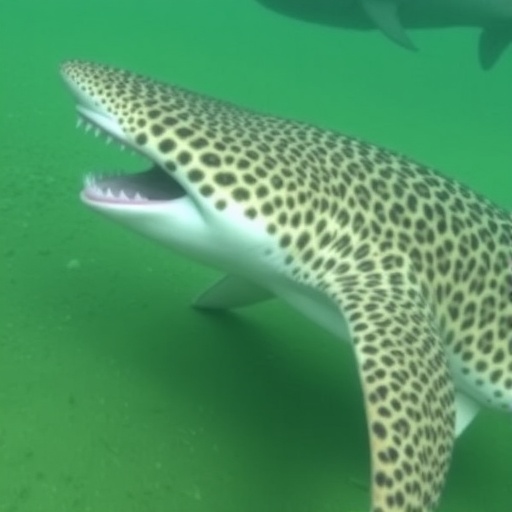A groundbreaking marine biology study has unveiled an extraordinary instance of group mating behavior among Indo-Pacific leopard sharks (Stegostoma tigrinum), marking the first scientific documentation of such a rare phenomenon in wild populations. Conducted off the coast of New Caledonia, this observation defies previous assumptions about the mating practices of these elusive and endangered sharks, revealing a complex social interaction that may have profound implications for understanding their reproductive strategies.
The lead researcher, Dr. Hugo Lassauce from the University of the Sunshine Coast (UniSC), captured a remarkable video sequence depicting two male leopard sharks engaging in rapid, sequential copulation with a single female. This documented event, described in the recently published article in the Journal of Ethology, provides invaluable insights into the reproductive ecology of Stegostoma tigrinum, a species scarcely studied in natural conditions due to its elusive behavior and declining numbers. Each shark involved measured approximately 2.3 meters in length, highlighting the substantial size of these creatures participating in this unique mating tableau.
Prior to this discovery, knowledge of Indo-Pacific leopard shark mating behavior was predominantly derived from observations in captivity, leaving a significant gap in understanding related to environmental cues and natural breeding interactions. The rarity of mating observations in the wild stems from both the species’ endangered status, classified by the International Union for Conservation of Nature (IUCN), and the general difficulty scientists face in documenting underwater reproductive behaviors in situ.
Dr. Lassauce’s year-long snorkeling surveillance program, conducted approximately 15 kilometers off New Caledonia’s coastline, was part of an extensive collaborative effort with the local Aquarium des Lagons. This long-term monitoring initiative aimed to gather baseline ecological data on leopard shark populations, their habitat use, and reproductive activities. During this period, while anecdotal signs of courting sharks had been noted, the complete courtship and copulation sequence had never been observed until this serendipitous encounter.
In the filmed event, researchers witnessed the female shark being firmly grasped by two males, one on each pectoral fin, as they initiated the mating ritual on the ocean floor. The behavior observed extended over a tense hour where Dr. Lassauce maintained a watchful position, undisturbed to avoid influencing the natural interaction. The copulation times were brief but intense: the first male engaged for 63 seconds, immediately followed by the second male for 47 seconds, each exhibiting significant exertion as evidenced by their subsequent immobility on the seabed.
This sequential mating strategy, involving two males in rapid succession, raises fascinating questions about the evolutionary advantages and genetic benefits to females in this species. Such behavior could enhance genetic diversity within a single clutch of eggs, a critical factor for the species’ resilience given their endangered status and fragmented populations across the Indo-West Pacific region. The involvement of multiple males may also reflect complex mating systems or competition, a stark contrast to the generally solitary nature previously attributed to leopard sharks.
Leopard sharks, also commonly referred to as zebra sharks due to the distinctive striped patterning on juveniles, inhabit shallow coastal waters stretching from the east coast of Africa across to various Pacific islands and the Australian coastline. Despite their widespread distribution, the detailed aspects of their reproductive biology remain poorly understood, making in situ observations such as this invaluable. Understanding these behaviors is essential not only for biological knowledge but also for crafting targeted conservation strategies that address critical habitats and environmental pressures.
Co-authored by renowned marine ecologist Dr. Christine Dudgeon and Aquarium des Lagons scientists Dr. Olivier Chateau and research assistant Hugues Gossuin, the study emphasizes the significance of the New Caledonian site as a crucial reproductive ground for the species. Identifying and protecting such habitats is paramount for the conservation and management of Stegostoma tigrinum populations, particularly as human impacts and climate change increasingly threaten their coastal environments.
Beyond naturalistic study, this landmark observation also directs potential applications in conservation breeding and artificial insemination programs. These initiatives aim to “rewild” endangered shark populations, and understanding natural mating dynamics and multiple paternity patterns can deeply inform assisted reproduction methods. Consequently, the findings serve as a multidisciplinary bridge between field ethology, conservation biology, and applied marine veterinary sciences.
The discovery not only offers a vivid glimpse into the secretive life of an endangered marine species but also spotlights the importance of sustained, patient in-water research methods to reveal nuanced animal behaviors. Dr. Lassauce’s perseverance in returning weekly to the site, combined with the use of unobtrusive observation techniques, underscores the essential role of dedicated fieldwork for unlocking marine ecological mysteries.
As research progresses, scientists aim to expand genetic analyses of offspring to quantify paternal contribution within clutches, illuminating the full complexity of reproductive strategies in this and related shark species. This knowledge enhancement is poised to influence both evolutionary biology theories regarding mating systems and practical conservation management aimed at sustaining vulnerable marine populations.
This riveting documentation of a group mating event reshapes existing paradigms about shark reproductive behavior, unveiling an unexpected social dimension to one of the ocean’s most enigmatic animals. As the global scientific community digests these findings, it paves the way for deeper explorations into shark ethology and the ecological importance of maintaining biodiversity in marine ecosystems.
Subject of Research: Animals
Article Title: Observation of group courtship/copulating behavior for free-living Indo-Pacific Leopard sharks, Stegostoma tigrinum
News Publication Date: 18-Sep-2025
Web References: http://dx.doi.org/10.1007/s10164-025-00866-4
Image Credits: Hugo Lassauce-UniSC-Aquarium des Lagos
Keywords: Marine biology, Oceanography, Marine life, Ecology




